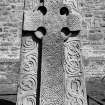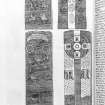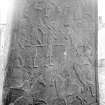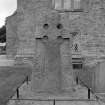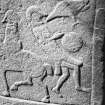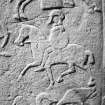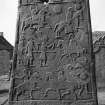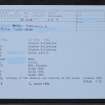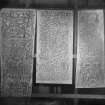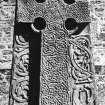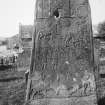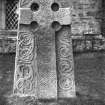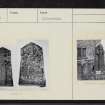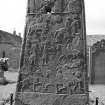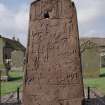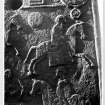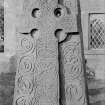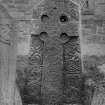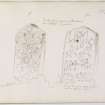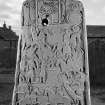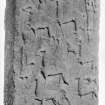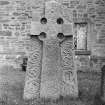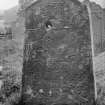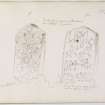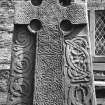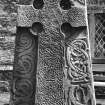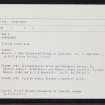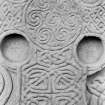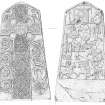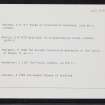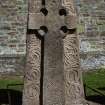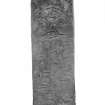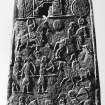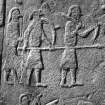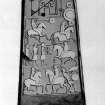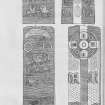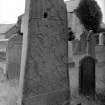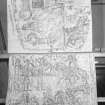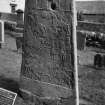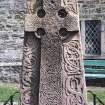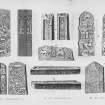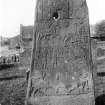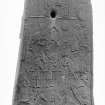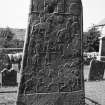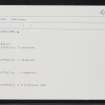Pricing Change
New pricing for orders of material from this site will come into place shortly. Charges for supply of digital images, digitisation on demand, prints and licensing will be altered.
Upcoming Maintenance
Please be advised that this website will undergo scheduled maintenance on the following dates:
Thursday, 9 January: 11:00 AM - 3:00 PM
Thursday, 23 January: 11:00 AM - 3:00 PM
Thursday, 30 January: 11:00 AM - 3:00 PM
During these times, some functionality such as image purchasing may be temporarily unavailable. We apologise for any inconvenience this may cause.
Aberlemno 2
Cross Slab (Pictish), Pictish Symbol Stone (Pictish)
Site Name Aberlemno 2
Classification Cross Slab (Pictish), Pictish Symbol Stone (Pictish)
Alternative Name(s) Aberlemno Churchyard
Canmore ID 34806
Site Number NO55NW 26
NGR NO 52238 55559
Datum OSGB36 - NGR
Permalink http://canmore.org.uk/site/34806
- Council Angus
- Parish Aberlemno
- Former Region Tayside
- Former District Angus
- Former County Angus
Aberlemno 2, Angus, Pictish cross-slab
Measurements: H 2.29m above ground, W 1.27m tapering upwards to 0.90m, D 0.20m
Stone type: sandstone
Place of discovery: NO 52239 55554
Present location: in situ in the churchyard at Aberlemno.
Evidence for discovery: first recorded in 1726 by Alexander Gordon.
Present condition: some wear but reasonably good overall. At some period prior to the late nineteenth century a hole has been drilled through the top right armpit of the cross on face A. In 1898 the stone was raised in situ to expose more of the base, and no socket stone was found.
Description
This majestic slab is carved on both broad faces in relief with incised details, the panel on face C stopping well short of the carving on face A. Although unornamented, the narrow faces are carefully dressed and the top rises into a pediment. Face A bears a ringed cross which spans the length and breadth of the slab and is outlined by roll mouldings. At the centre of the cross-head is a circle, outlined by roll moulding, which contains seven interlinked triple spirals. The side-arms contain diagonal key pattern, while the upper and lower arms are filled with interlace forming cruciform designs. The shaft below contains three roundels interlinked by the dense interlace that fills them. The background to the cross is filled with animals seen in profile. Either side of the upper arm of the cross is an animal with its head turned back and away from the cross, that on the left with a serpent’s body grasped in its jaws. To the left of the shaft there are three quadrupeds and a serpent biting one another, ingeniously designed to form four spirals, one above the other. On the right of the shaft is a double spiral knot composed of two creatures with elongated beaks, and below are two elegant sea-horses confronted in a figure of eight, protecting a triquetra knot between their lower fins.
Face C is bordered by a flat-band moulding, which turns into two gaping animal masks at the apex. The enclosed panel is divided into two by a horizontal roll moulding. The smaller top panel contains a notched rectangle with Z-rod symbol, ornamented with double spirals, to the right of which a triple disc symbol extends into the panel below. This larger panel tells the story of a battle in three registers. First a horseman with long hair and a sword raised in his right hand chases a helmeted warrior who has abandoned his sword and circular shield but is still grasping a spear in his left hand, fleeing to the right. Below three long-haired warriors armed with swords, shields and spears face an oncoming horseman with raised spear and shield hanging on his left side. At the foot of the panel, two horse-borne warriors face one another with raised spears and shields at the ready. Tucked into the bottom right corner is a large helmeted figure lying beside his shield, about to be pecked by a large bird. This evocative panel has been analysed by several authors, most fully in Cruickshank 1991 and Fraser 2002.
Date range: early eighth century.
Primary references: Gordon 1726, pl 53; ECMS pt 3, 209-14; Cruickshank 1991; Fraser, J E 2002; Fraser 2008, no 51.2.
Desk-bsed information compiled by A Ritchie 2018
NO55NW 26 52239 55554
For parish church and churchyard, see also NO55NW 28.
(NO 5223 5555) Cross Slab (NR)
OS 6" map (1970)
An upright cross-slab of Old Red Sandstone, 7ft 6ins high by 4ft 2ins wide at the bottom and tapering to 2ft 11 1/2ins wide at the top, by 8ins thick. The ornament is partly incised and partly relief, consisting of a cross edged by spirals, and on the reverse the two-legged rectangle, the Z-rod, the triple disc, and a battle scene consisting of three rows of figures.
J R Allen and J Anderson 1903
Field Visit (21 August 1958)
This large Cross Slab remains as described in front of the west gable of Aberlemno Church.
Visited by OS (JLD) 21 August 1958
Note (1983)
Aberlemno NO 5223 5555 NO55NW 26
A Class II Pictish cross-slab which stands in the churchyard immediately W of Aberlemno church. The cross is richly ornamented and the carvings on the back include a Z-rod, a triple disc, and the figures of armed riders and footmen.
RCAHMS 1983
(Stuart 1856, 24-5, plates lxxviii, lxxix; Allen and Anderson 1903, iii, 209-14).
Publication Account (1987)
This group of stones makes an excellent introduction to the range and skill of Pictish carving, beginning with the most easterly of the three stones beside the road. This is an early Pictish monument, unshaped and incised on one face with a serpent, a double disc and Z-rod and a mirror and comb. A group of prehistoric cup-marks low down on the reverse of this slab suggests that the Pictish sculptor made use of an existing standing stone. Both this and and the next slab have been moved to their present positions in recent times, unlike the great cross-slab which remains in its original position. The small centre stone may also be a prehistoric standing stone, although there are indistinct traces of a crescent and a curving line. The tall, narrow cross-slab is likely to be the latest of the Aberlemno group; it stands almost 3 m high and is heavily ornamented on every face, although weathering and pollution have sadly blurred the details. The cross-head is sculptured in high relief with bosses and panels reminiscent of the jewelled metal crosses used inside churches, and the shaft is flanked by angels, panels of interlace and animals. The sides of the slab are carved with a running spiral pattern. The back is dominated by two huge symbols, the crescent and V-rod and the double disc and Z-rod, both filled with decoration. The central panel contains a hunting scene, with a fine pair of trumpeters in the top right corner, and below are a centaur and the figure of David rending the jaws of a lion, accompanied by a sheep and a harp.
Better preserved and an outstanding example of Pictish art is the cross-slab in the churchyard, lovingly carved in the full range of a master craftsman's techniques, from light incision to high relief The cross stands some 12 cm proud of its background, representing colossal effort in removing unwanted stone, and its surface is intricately carved with interlace patterns. The background is carved with amusingly intertwined animals showing strong Northumbrian influence. If you begin at the feet of the animal at the bottom of the left-hand panel, you will be able to trace its hind-legs and tail within the circle of its elongated body curving round to its forelegs, and then its neck curving backwards until its jaws grasp the hindquarters of the next animal. The back of the slab is framed within two serpentine animals whose heads confront one another at the top (the hole is not part of the original design but appears to have been bored in more recent times). There are two symbols: a rectangle and Z-rod and a triple disc, and beneath them a panel containing the only known battle-scene in Pictish art. The horsemen and foot-soldiers are carved in an ingenious combination of incision and low relief that creates a sense of perspective. Middle left is a group of three foot-soldiers, armed with shields (shown in profile) and spears; the central figure holds his spear on his right side and it is carved in relief whereas the third soldier is carrying his spear in his left hand, lightly incised to show that it is further away.
Aberlemno is only some 10 km from the site of the battle of Nechtansmere, which took place in AD 685 near Dunnichen (a modem cairn at NO 509487 commemorates the battle, along with a cast of the symbol stone found nearby, which is now in Dundee Museum). It has been suggested that the Aberlemno battle-scene depicts the historic occasion of Nechtansmere, when the Picts defeated the Northumbrian army, and that the stone was erected some hundred years later to record the battle.
Information from ‘Exploring Scotland’s Heritage: Fife and Tayside’, (1987).
Reference (1997)
Class II symbol stone - Aberlemno 2 - showing a cross on the face. On the reverse is a divided rectangle and Z-rod beside a triple disc. Below these are a detailed battle scene.
A Mack 1997.
Note (May 2017)
Aberlemno
The modern village of Aberlemno is set roughly half way between Forfar and Brechin and comprises a couple of farms, a primary school, and a church, as well as the collection of four Pictish stones. Three are set in a row along the B9134, and one in the churchyard. Nos. 1 and 4 are relatively early in date, unshaped slabs bearing decoration usually dated to the 7th century AD (a type known by archaeologists as Class 1). One example, No. 1, also bears six cup-markings on one side, a type of decoration common in Scotland in early prehistory. No. 3 (perhaps in its original location) is a magnificent tall slab bearing a cross flanked by angels on one side, and a narrative panel on the other, perhaps relating the biblical story of David in the lion’s den. The combination of Christian and Pictish motifs here is known as Class 2, and suggests a slightly later date, in the 8th century.
Our focus is on Aberlemno No. 2 which has been re-erected in the churchyard (a hole bored through the slab may have been reused in its relocation). It too is a Class 2 Pictish symbol stone with an ornamented cross on one side and the depiction of a battle scene on the other, most recently dated to the middle of the 9th century. It is the work of a highly skilled craftsman who has infilled the cross with intricate knotwork and created a suite of mystical animals, including serpents and hippocamps (a sea-horse). On the reverse of the slab a group of typical Pictish symbols (notched rectangle, Z-rod and triple-disc) is set above three rows of figures which illustrate scenes from a battle.
Following Graeme Cruickshank’s 1985 hypothesis, it is still believed to be an illustration of the Battle of Dunnichen (or Nechtansmere) between the Picts and the Northumbrians, which occurred on 20 May 685. Sources describing the battle are few and far between, and we rely entirely on accounts provided by early historians Bede and Nennius, and those in the Irish Annals. The Pictish king Bridei is said to have scored a remarkable victory, trouncing the invading Northumbrian force and killing their king Ecgfrith: ‘from that time’, Bede wrote, ‘the hopes and strength of the English kingdom began to fade away’.
The location of the battle is uncertain although a site near Dunnichen Hill (about 6km south of Aberlemno) has long been favoured. In a recent reassessment of the evidence, historian Alex Woolf favoured Dunachton in Badenoch, an alternative explanation that might throw the interpretation of Aberlemno 2 into some doubt, since it lies on the other side of the Cairngorm mountains some 80km away.
The Battle Scene
The opposing combatants are readily identifiable. One side, thought to be the Picts, have long flowing hair while the other, the Northumbrians, wear distinctive helmets with nose guards. The upper row shows a Pictish horseman, sword in hand, pursuing his Northumbrian counterpart whose sword lies dropped behind him. The central scene shows three Pictish warriors with sword, spear and shield repelling an advancing Northumbrian horseman – perhaps a representation of a nodal point in the battle. The lowest row shows two apparently different scenes: in one, two horseman clash, in the other a bird pecks mercilessly at the body of a dead Northumbrian, perhaps King Ecgfrith himself. Two disks, one at the upper centre, another at the lower right, might represent the sun tracking across the sky during the fateful day.
While the stone undoubtedly represents a beautiful expression of Pictish artistic sensibility, we may have much to learn about it’s true story. With an art-historical attribution to the 9th century AD, its date lies two hundred years after the Battle at Dunnichen; the battle itself must certainly have occurred, but its location is still a matter of debate. To this we might add that the distinctive helmet of the ousted horseman may not turn out to be Northumbrian at all: the analogy draws on the discovery of a remarkable 8th century Anglo Saxon helmet at Coppergate, York, in 1982, and its superficial similarity to that shown on Aberlemno No. 2. Though compelling, it is far from certain.
At Aberlemno 2, art, history and archaeology come together to provide a plausible narrative, but one that may undergo significant revision in the coming years as archaeologists uncover more about Scotland’s Pictish kingdom.
Sources:
Allen and Anderson, J R and J (1903), ‘The Early Christian Monuments of Scotland’, 209, figs. 227A-B
Clarkson, T (2008), ‘The Aberlemno battle scene'
https://senchus.wordpress.com/2008/07/22/the-aberlemno-battle-scene/
Clarkson, T (2013), ‘Against iron swords: Dun Nechtáin, AD 685’
https://senchus.wordpress.com/2013/05/20/against-iron-swords-dun-nechtain-ad-685/
Fraser, I. (ed.). 2008. The Pictish Symbol Stones of Scotland. Edinburgh: RCAHMS.
HES (2015). Aberlemno Churchyard Cross Slab - Statement of Significance
Ritchie, A 1991 ‘Review: The Battle of Dunnichen by Graeme Cruickshank’
https://web.archive.org/web/20100825230203/http://www.pictart.org/6.htm
Sellar, A M (1907), ‘Bede’s Ecclesiastical History of the English People'
Woolf, A (2006) ‘Dun Nechtáin, Fortriu and the geography of the Picts’ Scottish Historical Review 85, 182-201.
Mike Middleton - Mapping Project Manger






























































